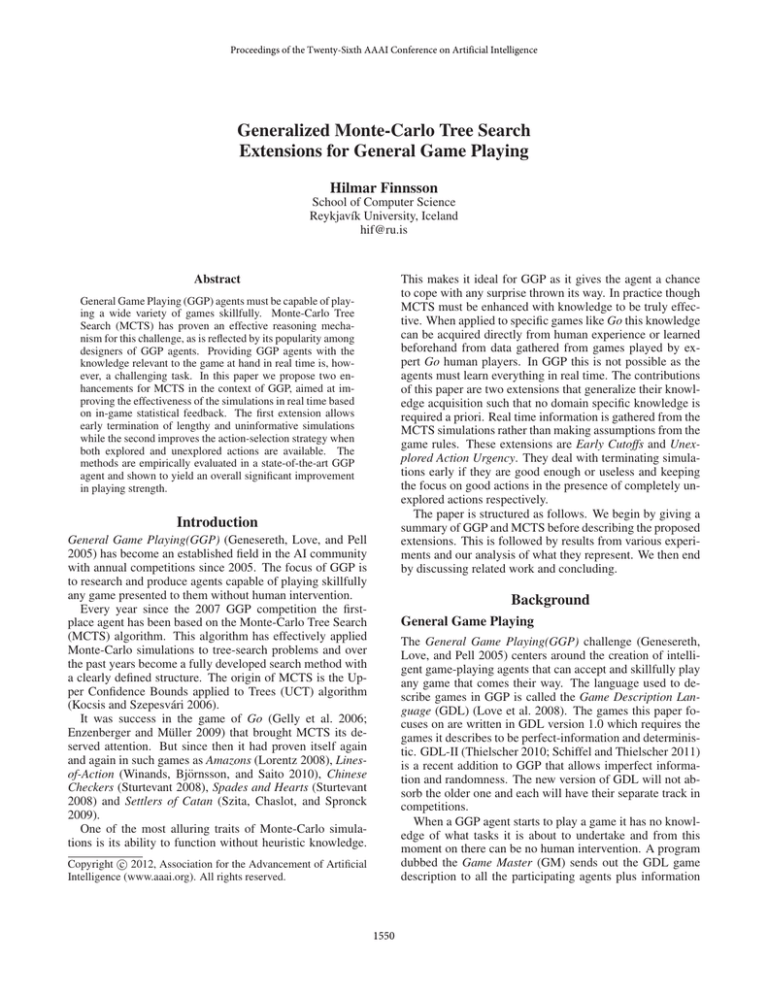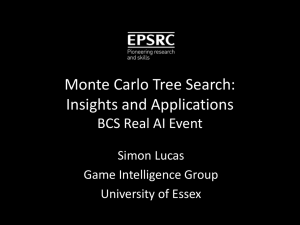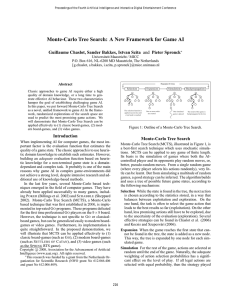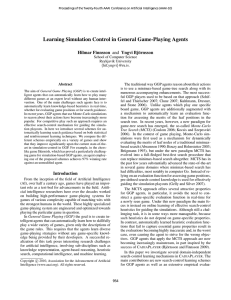
Proceedings of the Twenty-Sixth AAAI Conference on Artificial Intelligence
Generalized Monte-Carlo Tree Search
Extensions for General Game Playing
Hilmar Finnsson
School of Computer Science
Reykjavı́k University, Iceland
hif@ru.is
Abstract
This makes it ideal for GGP as it gives the agent a chance
to cope with any surprise thrown its way. In practice though
MCTS must be enhanced with knowledge to be truly effective. When applied to specific games like Go this knowledge
can be acquired directly from human experience or learned
beforehand from data gathered from games played by expert Go human players. In GGP this is not possible as the
agents must learn everything in real time. The contributions
of this paper are two extensions that generalize their knowledge acquisition such that no domain specific knowledge is
required a priori. Real time information is gathered from the
MCTS simulations rather than making assumptions from the
game rules. These extensions are Early Cutoffs and Unexplored Action Urgency. They deal with terminating simulations early if they are good enough or useless and keeping
the focus on good actions in the presence of completely unexplored actions respectively.
The paper is structured as follows. We begin by giving a
summary of GGP and MCTS before describing the proposed
extensions. This is followed by results from various experiments and our analysis of what they represent. We then end
by discussing related work and concluding.
General Game Playing (GGP) agents must be capable of playing a wide variety of games skillfully. Monte-Carlo Tree
Search (MCTS) has proven an effective reasoning mechanism for this challenge, as is reflected by its popularity among
designers of GGP agents. Providing GGP agents with the
knowledge relevant to the game at hand in real time is, however, a challenging task. In this paper we propose two enhancements for MCTS in the context of GGP, aimed at improving the effectiveness of the simulations in real time based
on in-game statistical feedback. The first extension allows
early termination of lengthy and uninformative simulations
while the second improves the action-selection strategy when
both explored and unexplored actions are available. The
methods are empirically evaluated in a state-of-the-art GGP
agent and shown to yield an overall significant improvement
in playing strength.
Introduction
General Game Playing(GGP) (Genesereth, Love, and Pell
2005) has become an established field in the AI community
with annual competitions since 2005. The focus of GGP is
to research and produce agents capable of playing skillfully
any game presented to them without human intervention.
Every year since the 2007 GGP competition the firstplace agent has been based on the Monte-Carlo Tree Search
(MCTS) algorithm. This algorithm has effectively applied
Monte-Carlo simulations to tree-search problems and over
the past years become a fully developed search method with
a clearly defined structure. The origin of MCTS is the Upper Confidence Bounds applied to Trees (UCT) algorithm
(Kocsis and Szepesvári 2006).
It was success in the game of Go (Gelly et al. 2006;
Enzenberger and Müller 2009) that brought MCTS its deserved attention. But since then it had proven itself again
and again in such games as Amazons (Lorentz 2008), Linesof-Action (Winands, Björnsson, and Saito 2010), Chinese
Checkers (Sturtevant 2008), Spades and Hearts (Sturtevant
2008) and Settlers of Catan (Szita, Chaslot, and Spronck
2009).
One of the most alluring traits of Monte-Carlo simulations is its ability to function without heuristic knowledge.
Background
General Game Playing
The General Game Playing(GGP) challenge (Genesereth,
Love, and Pell 2005) centers around the creation of intelligent game-playing agents that can accept and skillfully play
any game that comes their way. The language used to describe games in GGP is called the Game Description Language (GDL) (Love et al. 2008). The games this paper focuses on are written in GDL version 1.0 which requires the
games it describes to be perfect-information and deterministic. GDL-II (Thielscher 2010; Schiffel and Thielscher 2011)
is a recent addition to GGP that allows imperfect information and randomness. The new version of GDL will not absorb the older one and each will have their separate track in
competitions.
When a GGP agent starts to play a game it has no knowledge of what tasks it is about to undertake and from this
moment on there can be no human intervention. A program
dubbed the Game Master (GM) sends out the GDL game
description to all the participating agents plus information
c 2012, Association for the Advancement of Artificial
Copyright Intelligence (www.aaai.org). All rights reserved.
1550
job balancing exploration and exploitation with regards to
the information in the MCTS tree and converges to the best
action given enough samples. UCT selects the most informative action which is considered to be a∗ when selected
from the set of available actions A(s) in state s using the
following:
(
∗
a = argmaxa∈A(s)
Avg(s, a) + 2 ∗ Cp
s
ln Cnt(s)
Cnt(s, a)
)
The function Avg returns the average reward observed
when taking action a in state s and Cnt returns the number of times state s has been sampled or how often action
a has been selected in state s, depending on the parameters. The Cp parameter is a tunable variable which can be
used to influence the exploration/exploitation balance with
higher values giving more exploration. The balancing part
of the formula is known as the UCT Bonus. In Figure 1 the
selection phase lasts from state S up to but not including the
state N .
Figure 1: An overview of a single simulation
Playout
about what role they play and the time controls. The time
controls are known as startclock and playclock. The former
gives the time in seconds until the actual gameplay will begin relative to when the GDL was received and the latter is
the think time between moves. All GDL games are at their
core a simultaneous move game as agents are required to
send the GM a move on every turn, but turn-taking is easily
emulated with alternating ineffectual dummy moves. The
GM is responsible for informing all agents about all moves
made within the game until it terminates.
At some point during the simulation it will fall out of the
in-memory MCTS tree. This marks the start of the Playout phase. The basic strategy in this phase is just to play
uniformly at random. This phase includes everything from
state N to and including state T in Figure 1.
Expansion
The name of this phase refers to expanding the in-memory
MCTS tree. The most common strategy here is expanding
the tree by one state each simulation, the added state being the first state of the playout phase (Coulom 2006). This
way the MCTS tree grows most where the selection strategy
believes it will encounter its best line of play. For the simulation in Figure 1 this means that state N is incorporated
into the MCTS tree.
Monte-Carlo Tree Search
MCTS uses its deliberation time to generate information
from simulation rewards. While running these simulations
an in-memory tree is built to store the generated information, henceforth called the MCTS tree. This tree reflects the
top part of the actual tree described by the game it is playing. Just like the simple Monte-Carlo method, the algorithm
uses the data gathered at the root to decide on the next move
to make.
This process has been formally separated into four consecutive tasks or phases. These are selection, playout, expansion, and back-propagation. Each of these phases can
be implemented a number of ways independently but in this
description we will keep it simple by focusing on the most
basic version which is usually a good starting point for any
MCTS application. As a visual reference Figure 1 will be
used. It depicts a single simulation beginning at state S running through the MCTS tree (the shaded area) and some unknown part of the game tree before terminating at state T .
Back-Propagation
The back-propagation phase controls how the end reward
of the simulation is used to affect the traversed states of the
current MCTS simulation path. In the basic implementation,
just as with MC simulations, this keeps track of the average
rewards. To distinguish state rewards at different distances
from terminal states, a discounting factor can be applied to
the reward as it is backed up from the terminal state to the
root.
Generalizing MCTS Extensions
In GGP it is a difficult task to generate reliable knowledge
and can even backfire, causing undesirable behavior in the
agent. The difficulty of knowledge generation has in part
contributed to the popularity of the MCTS agent in the field
as in its purest form it needs no prior knowledge to play any
game. Extending MCTS with knowledge can produce great
results but the improvement gain relies heavily on the quality of the knowledge used. Any attempt of injecting such
Selection
With every simulation run the MCTS tree expands and while
a simulation is within this tree it has access to information
on how earlier traversals of the collected states have fared.
The UCT (Kocsis and Szepesvári 2006) formula does a good
1551
way correlated with what is actually happening in the game
as it plays out. If this value jumps back and forth continuously or never changes it is deemed unrelated to the game
progression. To calculate the stability value the variance of
the changes in the score obtained from the Goal relation is
observed throughout the simulations and then averaged over
them. If the resulting stability value is lower than a predetermined threshold but not zero this score is believed to be
stable and the extension is activated.
The pseudo-code in Algorithm 1 outlines the decisionmaking process if an early cutoff should be made and we
use it as a reference throughout this section. It is called right
after checking if the current state is terminal and before any
actions retrieval or selection is made to transition to the next
state. The variables useEarlyCutoff is true if the extension
is active and playoutSteps always contains the current number of states traversed since the current simulation left the
MCTS tree.
The Goal stability part of the extension has precedence
and once it has been activated it terminates simulations and
scores them with the Goal relation as shown with the conditional function IsGoalStable in Algorithm 1. The cutoff
length is set as the distance from the initial state of the game
to the first state where the goal changes with the number of
players participating added. It is then checked relative to
how many playout steps have been taken. This way the simulations should immediately start to draw attention towards
the parts of the state space where something is to be gained.
The player count addition is made to allow at least one round
to be played beyond the goal point if there is an immediate
neutralizing response, not to mention if it is a forced one.
These variables are only set in the beginning at the same
time the stability is determined and therefore keep the same
distance from the MCTS tree fringe throughout the game.
In order to predict if a simulation is a waste of time due
to its length the agent collects data on at what depth terminal states are encountered and uses it to estimate the depth
interval in which they occur. If the interval is very narrow
or always at the same depth, there is no use making early
cuts as little or no time can be saved by doing so. The minimum interval size is set equal to the variable minimumSteps
seen in Algorithm 1 where it is also used as a failsafe for a
minimum number of playout steps that must be made for a
cut to be considered. If it is found that the interval is sufficiently big the extension becomes active through the conditional function hasTerminalInterval() in Algorithm 1.
As before a cutoff depth is set and then checked relative
to the MCTS tree fringe by keeping track of the number of
steps taken in the playout phase. The cutoff depth is set
relative to the initial state and matches traversing the third
of the interval where terminal states have been observed. As
an example lets say we have a game where terminal states
have been reached from depths 20 to 50 relative to the initial
state. The cutoff depth is then:
1
20 + ∗ (50 − 20) = 20 + 10 = 30
3
If we then exit the MCTS tree at depth 8 from the initial state
the simulation will be terminated at depth 38. A terminal
interval cutoff defaults to a draw (GGP score of 50).
extensions into an MCTS GGP agent must take into consideration at least two possible scenarios. The extension may
be harmful in some games if the knowledge it utilizes is not
general enough and in some cases it may not be applicable
at all and should be ignored.
Following are generalizations of two extensions for
MCTS. They make use of statistical information gathered
in real time from the simulations rather than making static
assumptions from the game rules.
Early Cutoffs
Without knowledge to guide the MCTS simulations huge
amounts of computation time may be wasted on irrelevant
continuations in the playout phase. There is a danger of
simulations running for a long time, missing a lot of obvious
good moves or even just going around in circles in the state
space. When they finally end up in a terminal state the information backed up in the tree may be just noise. Also, to
ensure that games are deterministic, GGP games often encode a counter into their rules to terminate game playouts
that have gone beyond reasonable length and scores them
as a draw without any regards to who is closer winning. If
it would be possible to predict that a simulation is headed
nowhere it would be better to terminate it immediately and
use the time saved to run another simulation that has a better
chance of generating more relevant information.
In other cases simulations may have entered a part of the
state space when one player is in such a good position that
it is not necessary to continue and better to score the game
immediately so another simulation can run. It may even be
enough to know when in the playout phase the simulation
discovers a better or worse position for the agent and returning back this information.
This extension covers two cases when simulations can be
terminated early. On one hand is the case when a simulation
can be evaluated to an informative score before reaching a
terminal state and on the other hand is the case when the
simulation has gone on longer than any rational play of the
game would without reaching a terminal state.
Before cutoffs can be made we first gather data on if the
extension is applicable to the game being played. This is
done by observing the “normal” simulations of the agent to
get information on if the extension should be activated and
if so how should its setting be. This data includes the depth
of terminal states and therefore needs naturally terminated
simulations.
To see if it is possible to evaluate the states we use the
scoring mechanism of GDL, the Goal relation. The trouble
here is that it makes no promises of returning useful information, if any at all, in non-terminal states. Still in some
games it can give a good estimation on the state as a result
of how the game rules are written. To make sure that the
Goal relation can be used we check it for a property called
Stability. The notion of stability in GGP was invented for
the agent ClunePlayer (Clune 2008) and was used to determine if a feature extracted from the game description would
be useful in evaluating game positions. Stability is based on
the assumption that if a value calculated from a state changes
gradually throughout the course of the game it is in some
1552
Algorithm 1 Pseudo-code for deciding cuts for the Early
Cutoff extension
if not useEarlyCutoff then
return false
end if
if playoutSteps < minimumSteps then
return false
end if
if IsGoalStable() then
// Cutoff point has been calculated as:
// cut ← firstGoalChange + numPlayers
return playoutSteps ≥ cut
end if
if hasTerminalInterval() then
// Cutoff point has been calculated as:
// cut ← firstTerminal + 0.33 ∗ terminalInterval
return playoutSteps ≥ cut
end if
Algorithm 2 Pseudo-code for action selection when using
the Unexplored Action Urgency extension
if state.explored = ∅ then
// We are in the Playout phase
return playoutStrategy(state.unexplored)
end if
action ← selectionStrategy(state.explored)
if state.unexplored = ∅ then
// Fringe not reached in the Selection phase
return action
end if
// Fringe reached in the Selection phase
exploit ← action.uctValue
discount ← state.unexplored.size()
/ state.actions.size()
√
urgency ← 50 + Cp ∗ ln state.visits() * discount
if exploit ≥ urgency then
return action
else
return playoutStrategy(state.unexplored)
end if
The reason for one third being the fraction of the terminal
state interval traversed as a minimum for a cut to be made
was based on results from Finnsson and Björnsson (Finnsson and Björnsson 2011). They show that pushing back an
artificial termination depth to give a UCT agent more chance
to find a real terminal state does not equal better play through
better information. In the example game there the agent
reached its peek performance as early as only finding a real
terminal state 30% of the time. From those results, traversing the top one third of the terminal state interval as an absolute minimum is a reasonable setting for this parameter.
subset of explored actions in the state or the playout strategy
on the subset of the unexplored actions. We call the value
assigned to the unexplored actions their urgency, which is
a phrase used when knowledge is used to assign values to
actions in (Bouzy 2005).
Pseudo-code for the urgency calculations is shown in Algorithm 2. The variable state accesses the current simulation state and from it we get three action sets, unexplored
actions, explored actions, and all actions. The exploit
variable stores the highest UCT value of the already explored actions in the state and the urgency variable holds
the urgency of the unexplored actions. The formula for the
urgency is actually the UCT formula as it would look for
an action that has been tried once before in this state and
resulted in an immediate draw (GGP scores range from 0
to 100). The discount variable has the purpose of lowering
the urgency as more and more actions get explored. We have
the discount because with fewer and fewer actions left unexplored, the more likely we are to have already come across
the best available action. By incorporating the UCT formula
into this decision we keep the guarantee of all actions getting
explored in the limit.
This extension relies on the agent actually selecting a
good action early on when exhausting the unexplored actions in a state on the MCTS fringe. It is likely that given
a uniform random playout strategy this extension will simply get balanced out and no improvements are made. This
extension has to be paired with a playout strategy that shifts
the action selection in favor of selecting good actions early.
Given such a playout strategy this extension should boost its
effect while not causing harm if it turns out only as good as
the uniform random strategy in some games. An example of
such an extension is the Move-Average Sampling Technique
(MAST) (Finnsson and Björnsson 2008) which we will use
in order to evaluate this extension in the experiments section
of this paper.
Unexplored Action Urgency
In GGP it is commonplace to use UCT in the selection phase
to control the exploration/exploitation balance in MCTS. By
default UCT never exploits on the fringe of the MCTS tree,
always selecting amongst the unexplored actions available.
It is not until all unexplored actions have been exhausted that
attention is given to exploitation in the state. When domainspecific knowledge is available unexplored actions can be
evaluated and bad ones ignored. This may sound excessive
but if the knowledge is accurate, the agent would never have
selected the bad action anyway.
The main idea with the extension is to make it possible
for the agent to exploit actions on the MCTS tree fringe if
there is reason to do so. Even though no domain specific
knowledge is available we can observe how the rewards of
an action accumulates. Basically if the reward is consistently very good the action estimated average will stay high
no matter how often we select. So if an action fits this description we are now going to prefer it over any unexplored
action found in the state while the number of simulations
traversing this state is low. Instead of the default rule with
unexplored actions taking precedence a quick decision point
is added when the agent is on the MCTS fringe. The decision of selecting an unexplored action is given a value that
can be compared with the highest UCT value of the already
explored actions and the higher value wins. Basically the
agent is selecting between using the selection strategy on the
1553
Empirical Evaluation
table. Also a UCT agent extended with MAST was used.
MAST has the ability to bias the playout action selection
in many games towards good actions, allowing the hypothesized consequences of Unexplored Action Urgency extension to be checked. In Table 2 the base agents are extended
with both extensions to reveal the overall gain and test for
any improvement overlap. The third base player in that
table, the RAVE/MAST/FAST agent is the extension combination used by the GGP agent C ADIA P LAYER (Finnsson
and Björnsson 2008) in the GGP competition in 2011. C A DIA P LAYER is a two-time winner of the competition and
came in second in the 2011 competition and can therefore
be considered as one of the top GGP agents. We matched
this player against an extended version of itself to answer
if the proposed extensions can help an agent of such caliber. Information on Rapid Action Value Estimation (RAVE)
can be found in (Gelly and Silver 2007) and please refer to
(Finnsson and Björnsson 2010) for information on Featuresto-Action Sampling Technique (FAST). The failsafe variable
for minimum steps in the Early Cutoff extension was set to
10.
Both extensions were implemented into a GGP agent, just as
they are intended to be used, and therefore all experiments
were run as GGP games.
Games Used
The extensions were tried on the ten different games listed
in Tables 1 and 2, many of them well-known although some
need some explanations. Amazons small is Amazons on a
6 × 6 board. Battle is a simultaneous move game played
on an 8 × 8 board where each player has 20 disks along the
edges of two adjacent sides that can move one square or capture an opponent disks next to them. The goal is to be the
first to capture 10 opponent disks. Breakthrough is a turntaking race to the back ranks of the opponent using chesslike pawns. The initial setup is the same as in chess with all
pieces replaced by these pawns in the corresponding color.
The pawns can move forward or diagonally one square at a
time and when moved diagonally they may capture an opponents piece. Chinook is a games presented at the 2010 GGP
competition and is a breakthrough type game using pieces
that move like Checkers pawns. Chinook also has simultaneous moves such that White alternates moving pawns on
white and black squares each ply starting with a pawn on a
white square while Black moves simultaneously one of its
pawns that reside on the opposite colored squares. Knightthrough is also a breakthrough type game played with chess
knights that may only play knight-type moves that advance
them on the board. Runners is a simple simultaneous game
where two runners can at every ply select from standing still
or taking one, two or three steps forwards or backwards. The
runners then race to a goal 50 steps away and have 50 actions
to reach it. This game’s GDL encoding is deceptively tricky
in its simplicity for the kind of statistical data simulations
rely upon. Skirmish is a game with chess pieces where the
object is simply to capture all the pieces of the opponent.
In this version each player has four pawns which can only
move by capturing, two knights, two bishops and two rooks.
In addition the squares at c3, c6, f3 and f6 are off limits.
Results
The results for the Early Cutoff extension show very significant improvement in the games Battle, Checkers and Skirmish both with and without the MAST extension. Also it
is important to point out that in other games where this extension is active it shows little or no sign of having adverse
effects on the agent. Regarding the games that did not activate the extension, lets take a closer look at Othello as an
example. It has only extremely rare instances of the game
ending before the board has been filled making the terminal
interval just a single value when sampled. The player who
has more disks wins and this is the information the Goal
relation gives at every state of the game. This information
goes back and forth in declaring which player is winning
and therefore gets evaluated as unstable by the extension.
This matches the generally known fact that the difference in
number of disks is a bad heuristic for Othello.
The Unexplored Action Urgency extension yields significant improvements on many of the games and as expected it
needs an informed playout strategy to work. This is confirmed by the fact that almost no improvement is gained
when joined with the random playouts of UCT while the
MAST joining shows significant improvements in six out of
the 10 games. The results for Runners are very curious as
it improves the agent in this game single handedly without
the aid of MAST. It appears that for some games keeping
focus on actions that seem good by relatively few random
samples can help. Also it is a bit disappointing to see that
Skirmish seems to suffer when using this extension. Because
the development of MAST was inspired by problems UCT
encountered when playing Breakthrough, it is not surprising
to see the biggest improvements there.
When the extensions have been joined together, the improvements they provide do not seem to overlap except in
the case of the quirky Runners game and Battle, even though
still at approximately 75%, does worse than without the Unexplored Action Urgency in the UCT case. With MAST we
Setup
The agents ran on a single Intel Xeon 2.66GHz, 3.00GHz
or 3.20GHZ CPU (competing agents always on matching
CPUs) and every game type was run as a tournament between two agents with 300 game instances played, having
the agents switch roles half way through. In every game the
agents were given 10 seconds both for the startclock and the
playclock. The number of sample simulations for the Early
Cutoff extensions was set as 100 and its stability threshold
as 1000. The results are displayed in Tables 1 and 2. The
cells marked as -N/A- under the Early Cutoff extension are
games where the extension decided that it should not activate. In every tournament an extended agent was pitched
against the base agent it was derived from. All cell data is
the winning percentage of the extended agent along with a
95% confidence interval.
The base agent used was a basic UCT/MCTS agent as
described in this paper and enhanced with a transposition
1554
Early Cutoff
vs.UCT win %
-N/A87.50 (± 3.62)
53.00 (± 5.66)
72.83 (± 4.79)
46.17 (± 5.49)
54.67 (± 5.64)
-N/A53.33 (± 5.52)
58.17 (± 5.39)
63.67 (± 5.13)
61.17
Game
Amazons Small
Battle
Breakthrough
Checkers
Chinook
Knightthrough
Othello
Pentago
Runners
Skirmish
Overall
Game
Amazons Small
Battle
Breakthrough
Checkers
Chinook
Knightthrough
Othello
Pentago
Runners
Skirmish
Overall
Table 1: Isolated Extension Tournaments
Early Cutoff Unexplored Action Urgency
vs. MAST win %
vs. UCT win %
-N/A56.33 (± 5.62)
73.33 (± 4.97)
46.33 (± 5.52)
51.67 (± 5.66)
44.33 (± 5.63)
74.33 (± 4.71)
48.33 (± 5.41)
52.17 (± 5.53)
50.17 (± 5.56)
47.67 (± 5.66)
51.33 (± 5.67)
-N/A47.83 (± 5.54)
51.00 (± 5.53)
45.17 (± 5.54)
62.67 (± 5.34)
59.50 (± 5.36)
67.67 (± 4.97)
41.50 (± 5.26)
60.06
49.08
Table 2: Combined Extensions Tournaments
Early Cutoff +
Early Cutoff +
Unexplored Action Urgency Unexplored Action Urgency
vs. UCT win %
vs. MAST win %
58.33 (± 5.57)
60.67 (± 5.54)
74.67 (± 4.80)
74.67 (± 4.82)
52.33 (± 5.66)
68.33 (± 5.27)
71.00 (± 4.87)
71.33 (± 4.82)
44.33 (± 5.48)
63.83 (± 5.32)
48.00 (± 5.66)
65.67 (± 5.38)
45.83 (± 5.58)
54.67 (± 5.57)
47.67 (± 5.57)
47.33 (± 5.60)
62.17 (± 5.43)
59.83 (± 5.47)
58.50 (± 5.28)
61.67 (± 5.29)
56.28
62.80
have significant improvements on eight of the ten games plus
Othello being close as it did go over the significance threshold in Table 1 and does not activate the Early Cutoff extension.
Regarding the question if these extensions can improve
upon the state-of-the-art in GGP we see that there are significant improvements for six of the games resulting in over
12% overall improvement on this set of games.
Unexplored Action Urgency
vs. MAST win %
56.67 (± 5.62)
54.00 (± 5.50)
70.67 (± 5.16)
52.00 (± 5.33)
63.67 (± 5.33)
61.00 (± 5.53)
58.50 (± 5.46)
42.00 (± 5.46)
57.83 (± 5.41)
45.17 (± 5.38)
56.15
Early Cutoff +
Unexplored Action Urgency
vs. RAVE/MAST/FAST win %
56.33 (± 5.62)
84.33 (± 3.99)
73.33 (± 5.01)
65.83 (± 5.12)
54.33 (± 5.47)
85.00 (± 4.05)
47.83 (± 5.52)
45.67 (± 5.55)
56.17 (± 4.52)
54.33 (± 5.41)
62.32
rely on pre-coded evaluation knowledge.
The Unexplored Action Urgency extension resembles extensions that include domain specific knowledge in selecting
between actions in the playout phase. The notion of move
urgency was used in (Bouzy 2005) when playing Go. There
knowledge about Go is used to bias the selection probability
distribution of playout moves from being uniform to reflect
what is known, that is moves that are known to be good become more urgent. Move urgency is widely used in successful Go programs.
Related Work
Early cutoffs have been used before in MCTS game playing
agents in an effort to get better information through more
simulations. I NVADER MC (Lorentz 2008) is an MCTS
agent made for the game Amazons that utilizes this kind of
extension. It terminates a simulation when it has reached
a fixed number of playout-steps, returning a heuristic evaluation of the reached state. This extension is also used in
the game Lines of Action (Winands and Björnsson 2009),
where it has the more appropriate name Evaluation Cut-offs.
There the cutoff is not made until the evaluation function has
reached a certain score instead of having the length of the
simulation dictate when to cut. However, both approaches
Conclusion
In this paper we described how two MCTS extensions can be
generalized for practical use in GGP agents. The two extensions show genuine improvements to basic agents without,
as far as we can tell, displaying any severe adverse effects
when they do not help. When merged with a GGP agent
that is armed with extensions that allow it to reach competition level strength, both these extensions still offer overall
improvements.
1555
References
and Winands, M. H. M., eds., Computers and Games, volume 5131 of Lecture Notes in Computer Science, 37–49.
Springer.
Szita, I.; Chaslot, G.; and Spronck, P. 2009. Monte-Carlo
tree search in Settlers of Catan. In van den Herik, H. J.,
and Spronck, P., eds., Advances in Computer Games, volume 6048 of Lecture Notes in Computer Science, 21–32.
Springer.
Thielscher, M. 2010. A general game description language
for incomplete information games. In Proceedings of the
Twenty-Fourth AAAI Conference on Artificial Intelligence
(AAAI-10), Atlanta, Georgia, USA, 994–999. AAAI Press.
Winands, M. H. M., and Björnsson, Y. 2009. Evaluation function based Monte-Carlo LOA. In Twelfth International Advances in Computer Games Conference (ACG
2009), Pamplona, Spain. 33–44.
Winands, M. H. M.; Björnsson, Y.; and Saito, J.-T. 2010.
Monte Carlo Tree Search in Lines of Action. IEEE Transactions on Computational Intelligence and AI in Games
2(4):239–250.
Bouzy, B. 2005. Associating domain-dependent knowledge
and Monte Carlo approaches within a Go program. Information Sciences 175(4):247–257.
Clune, J. E. 2008. Heuristic evaluation functions for general
game playing. PhD dissertation, University of California,
Los Angeles, Department of Computer Science.
Coulom, R. 2006. Efficient selectivity and backup operators
in Monte-Carlo tree search. In Proceeding of the Fifth International Conference on Computers and Games (CG 2006),
Turin, Italy, 72–83.
Enzenberger, M., and Müller, M. 2009. Fuego - an opensource framework for board games and Go engine based on
Monte-Carlo tree search. Technical Report 09-08, Dept. of
Computing Science, University of Alberta.
Finnsson, H., and Björnsson, Y. 2008. Simulation-based
approach to general game playing. In Proceedings of the
Twenty-Third AAAI Conference on Artificial Intelligence,
AAAI 2008, Chicago, Illinois, USA, 259–264. AAAI Press.
Finnsson, H., and Björnsson, Y. 2010. Learning simulation control in general game-playing agents. In Proceedings
of the Twenty-Fourth AAAI Conference on Artificial Intelligence, AAAI 2008, Atlanta, Georgia, USA, 954–959. AAAI
Press.
Finnsson, H., and Björnsson, Y. 2011. Game-tree properties and MCTS performance. In The IJCAI Workshop on
General Game Playing (GIGA’11).
Gelly, S., and Silver, D. 2007. Combining online and offline
knowledge in UCT. In Proceedings of the Twenty-Third International Conference (ICML 2006), Pittsburgh, Pennsylvania, USA, volume 227, 273–280. ACM.
Gelly, S.; Wang, Y.; Munos, R.; and Teytaud, O. 2006. Modification of UCT with patterns in Monte-Carlo Go. Technical
Report 6062, INRIA.
Genesereth, M. R.; Love, N.; and Pell, B. 2005. General Game Playing: Overview of the AAAI competition. AI
Magazine 26(2):62–72.
Kocsis, L., and Szepesvári, C. 2006. Bandit based MonteCarlo planning. In Proceeding of the Seventeenth European
Conference on Machine Learning (ECML 2006), Berlin,
Germany, 282–293.
Lorentz, R. J. 2008. Amazons discover Monte-Carlo.
In Proceedings of the Sixth International Conference on
Computers and Games (CG 2008), Beijing, China, 13–24.
Springer-Verlag.
Love, N.; Hinrichs, T.; Haley, D.; Schkufza, E.; and Genesereth, M. 2008. General Game Playing: Game description language specification. Technical Report March 4 2008,
Stanford University.
Schiffel, S., and Thielscher, M. 2011. Reasoning about
general games described in GDL-II. In Proceedings of
the Twenty-Fifth AAAI Conference on Artificial Intelligence (AAAI-11), San Francisco, California, USA, 846–851.
AAAI Press.
Sturtevant, N. R. 2008. An analysis of UCT in multiplayer games. In van den Herik, H. J.; Xu, X.; Ma, Z.;
1556







